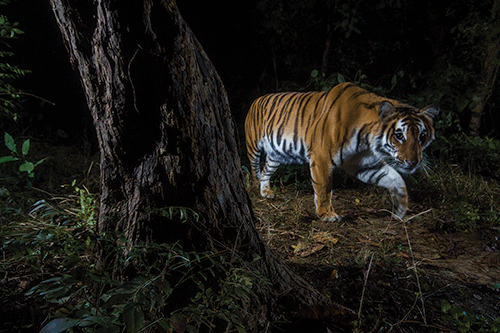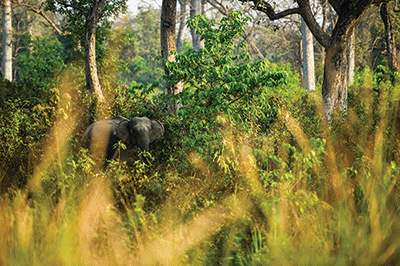Photo: Pramod Neupane-WWF Nepal
From red pandas swaying on branches in the eastern Himalayas to koalas clinging to tree trunks in southeastern Australia, all species exist on a delicate system of interconnectedness and interdependence. Roaming this earth long before human evolution and rapid development, their widespread existence are indicators of healthy ecosystems.
But their future is grim. The Living Planet Index estimates that wildlife populations around the world have declined by an astonishing 60% in just 40 years. Meanwhile 90% of seabirds are found to have plastics in their stomachs, compared to just 5% in the 1960s, and freshwater species have seen an 83% decline since 1970.
Despite these declining global trends, Nepal, while geographically small, stands tall in this arena, emerging as a powerhouse in wildlife conservation; a feat possible due to the continued commitment of the Government of Nepal, complemented by the passion and perseverance of local communities, and supported by national and International conservation organizations.
Photo: WWF Nepal
Despite the odds--including a continually changing political scenario, influx of natural disasters and the burgeoning global climate emergency--Nepal has shown encouraging progress in not just curbing the loss against nature but in contributing towards its increase. In 2018, Nepal made headlines globally as the first country to almost achieve the global target of doubling wild tigers by 2022. Meanwhile, the country has also achieved 365 days of zero poaching of rhinos on six occasions since 2011, a feat unreplicated by any country so far, while continuing to increase rhino numbers from as low as 100 in the late 1960s to 645 in 2015. While we have seen successes in protecting biodiversity within our national parks, illegal wildlife activities continue to filter through the cracks.
The Government of Nepal’s landscape approach towards conservation has formed a critical building block for the survival of key species. This approach has ensured the availability of contiguous habitats across countries by identifying critical corridors and bottlenecks for movement. The Khata region of Bardia, formerly a barren and degraded patch of land, is now a vibrant and well-trodden corridor for tigers and rhinos moving between Nepal’s Bardia National Park and India’s Katarniaghat Wildlife Sanctuary. And this is just one of seven corridors and three bottlenecks that facilitate this transboundary connectivity. These milestones highlight that through sustained partnerships and unwavering resolve, critical interventions can be made to restore wildlife; even those that are teetering closely to the brink of extinction.
Against this backdrop, Nepal has emerged as a major destination for wildlife tourism. Nature-enthusiasts are now flocking to the country’s national parks in record-breaking numbers. In July 2019, the number of tourists visiting Sauraha, Chitwan reached a historical peak--with over 180,000 tourists, marking a 56.50% growth since 2017. Nepal was recently named a “top destination for travelers to visit in 2020 and beyond” by Forbes Magazine, with special mention of “ethical safari experiences.” This recognition and growing emergence has helped reshape popular imagination: in the eyes of today’s global public, Nepal is no longer solely a country of snow-capped icy mountain peaks, it is also a country of dense jungles, arid Terai plains, and moving spots and stripes.
Wildlife tourism has also provided a lucrative source of income for local communities living alongside its protected parks. Homestays--run and managed by local communities who consider wildlife an inseparable part of their lives--have proliferated across sites such as Amaltari, Madi, and Dalla. Beyond fueling local economies, homestays have also provided a medium for cultural celebration and exchange, especially for Tharu communities, and contributed to conservation by reducing forest dependency among locals.
But these results have been double-edged. As wildlife numbers increase in Nepal, so do cases of human wildlife encounters and conflict. This issue has manifested throughout Nepal’s geography--from elephants claiming lives and houses in Terai to common leopards claiming livestock in the mid hills and the havoc-inducing monkeys wrecking crops across the country.
Another key challenge for future progress is continued habitat fragmentation, exacerbated by Nepal’s rapid linear infrastructural development plan. The need for sustainable green infrastructure and the importance of protecting critical corridors could not be overstated in this context. With 24% of Nepal falling under the purview of the protected area system, another area of focus in the coming days will also be to strengthen these existing management systems and mechanisms for protection, and enhance the participation and involvement of communities. Deserved attention should also be paid to areas beyond this system, especially as studies have shown their importance to large mammals.
With continued momentum, Nepal has the opportunity to serve as a live learning centre of excellence in wildlife protection and participatory conservation with the highest political commitment. But above all, a key step in maintaining this momentum for wildlife and ensuring a Nepal where people live in harmony with nature begins with the involvement of youth. Though Nepal’s positive environmental indicators are worth celebrating, the global declining trajectory for wildlife, coupled with today’s climate emergency, will present unparalleled challenges to youth. As the first generation with the knowledge that humans are destroying the planet and the last generation that can do anything about it, their role in advocating for the protection of wildlife and their habitats has become paramount.
While concrete jungles may physically separate many youth from the Terai’s wildlife, the ecological impacts of any environmental regression will affect us all, regardless of our geographical positioning. While previous generations have defined “development” in Nepal as urban expansion, today’s youth have the opportunity to reclaim the term to encompass the protection of natural heritage and wildlife.

Photo: Emmanuel Rondeau WWF US













